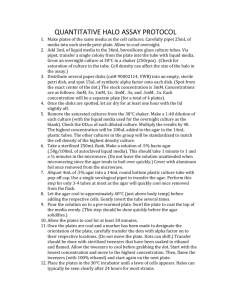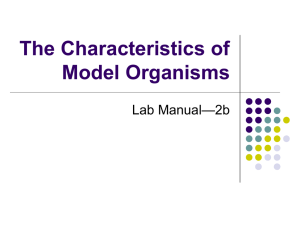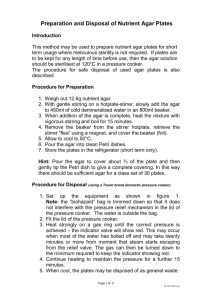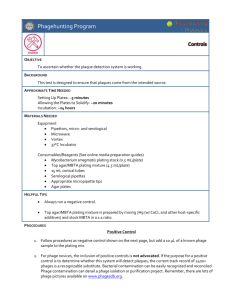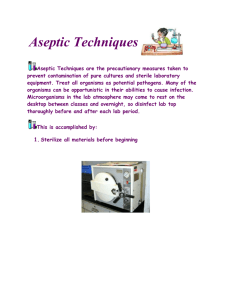R2A Agar: Microbiological Medium for Water Testing
advertisement
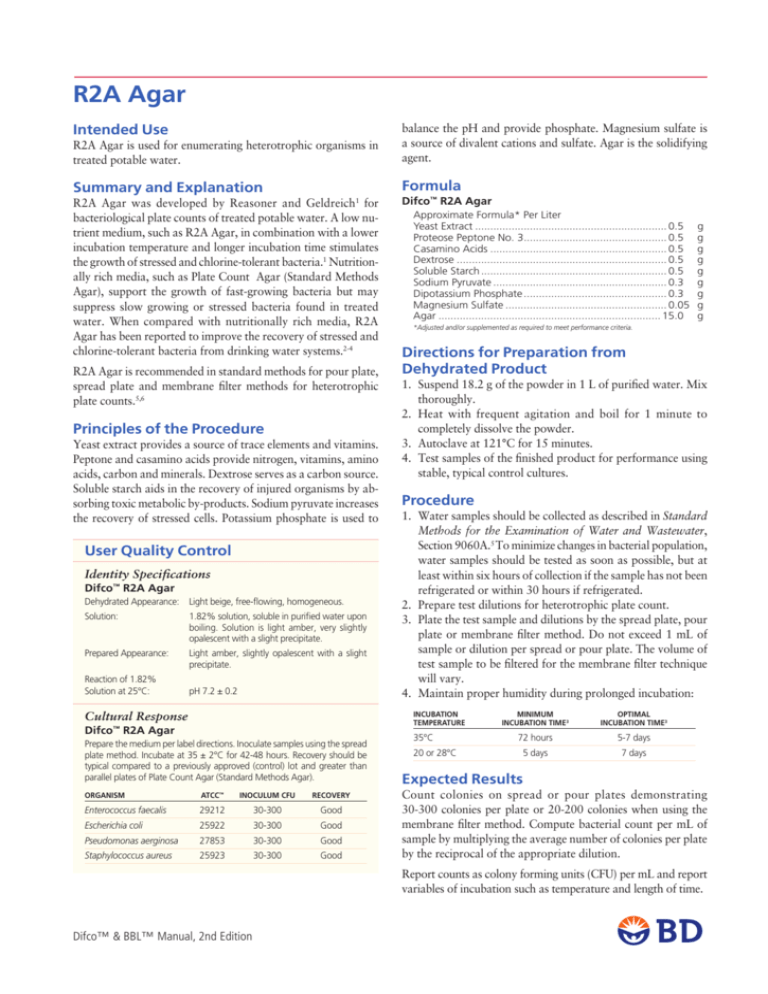
R2A Agar Intended Use R2A Agar is used for enumerating heterotrophic organisms in treated potable water. balance the pH and provide phosphate. Magnesium sulfate is a source of divalent cations and sulfate. Agar is the solidifying agent. Summary and Explanation Formula R2A Agar was developed by Reasoner and Geldreich1 for bacteriological plate counts of treated potable water. A low nutrient medium, such as R2A Agar, in combination with a lower incubation temperature and longer incubation time stimulates the growth of stressed and chlorine-tolerant bacteria.1 Nutritionally rich media, such as Plate Count Agar (Standard Methods Agar), support the growth of fast-growing bacteria but may suppress slow growing or stressed bacteria found in treated water. When compared with nutritionally rich media, R2A Agar has been reported to improve the recovery of stressed and chlorine-tolerant bacteria from drinking water systems.2-4 R2A Agar is recommended in standard methods for pour plate, spread plate and membrane filter methods for heterotrophic plate counts.5,6 Principles of the Procedure Yeast extract provides a source of trace elements and vitamins. Peptone and casamino acids provide nitrogen, vitamins, amino acids, carbon and minerals. Dextrose serves as a carbon source. Soluble starch aids in the recovery of injured organisms by absorbing toxic metabolic by-products. Sodium pyruvate increases the recovery of stressed cells. Potassium phosphate is used to User Quality Control Identity Specifications Difco™ R2A Agar Dehydrated Appearance: Light beige, free-flowing, homogeneous. Solution: 1.82% solution, soluble in purified water upon boiling. Solution is light amber, very slightly opalescent with a slight precipitate. Prepared Appearance: Light amber, slightly opalescent with a slight precipitate. Reaction of 1.82% Solution at 25°C: pH 7.2 ± 0.2 Cultural Response Difco™ R2A Agar Approximate Formula* Per Liter Yeast Extract................................................................ 0.5 Proteose Peptone No. 3................................................ 0.5 Casamino Acids........................................................... 0.5 Dextrose...................................................................... 0.5 Soluble Starch.............................................................. 0.5 Sodium Pyruvate.......................................................... 0.3 Dipotassium Phosphate................................................ 0.3 Magnesium Sulfate...................................................... 0.05 Agar.......................................................................... 15.0 *Adjusted and/or supplemented as required to meet performance criteria. Directions for Preparation from Dehydrated Product 1. Suspend 18.2 g of the powder in 1 L of purified water. Mix thoroughly. 2. Heat with frequent agitation and boil for 1 minute to completely dissolve the powder. 3. Autoclave at 121°C for 15 minutes. 4. Test samples of the finished product for performance using stable, typical control cultures. Procedure 1. Water samples should be collected as described in Standard Methods for the Examination of Water and Wastewater, Section 9060A.5 To minimize changes in bacterial population, water samples should be tested as soon as possible, but at least within six hours of collection if the sample has not been refrigerated or within 30 hours if refrigerated. 2. Prepare test dilutions for heterotrophic plate count. 3. Plate the test sample and dilutions by the spread plate, pour plate or membrane filter method. Do not exceed 1 mL of sample or dilution per spread or pour plate. The volume of test sample to be filtered for the membrane filter technique will vary. 4. Maintain proper humidity during prolonged incubation: Incubation Temperature Difco R2A Agar ™ Prepare the medium per label directions. Inoculate samples using the spread plate method. Incubate at 35 ± 2°C for 42-48 hours. Recovery should be typical compared to a previously approved (control) lot and greater than parallel plates of Plate Count Agar (Standard Methods Agar). ORGANISM ATCC INOCULUM CFU RECOVERY Enterococcus faecalis 29212 30-300 Good Escherichia coli 25922 30-300 Good Pseudomonas aerginosa 27853 30-300 Good Staphylococcus aureus 25923 30-300 Good ™ g g g g g g g g g 35°C 20 or 28°C Minimum Optimal Incubation Time3 Incubation Time3 72 hours 5-7 days 5 days 7 days Expected Results Count colonies on spread or pour plates demonstrating 30-300 colonies per plate or 20-200 colonies when using the membrane filter method. Compute bacterial count per mL of sample by multiplying the average number of colonies per plate by the reciprocal of the appropriate dilution. Report counts as colony forming units (CFU) per mL and report variables of incubation such as temperature and length of time. Difco™ & BBL™ Manual, 2nd Edition Limitations of the Procedure Availability 1. R2A Agar is intended for use only with treated potable water since it is recommended for compromised bacteria. 2. Use of the pour plate method is discouraged because recovery of stressed bacteria may be compromised by the heat shock (44-46°C) and low oxygen tension that are part of the procedure.7,8 3. Incubation time longer than indicated may be necessary to recover additional slow-growing bacteria. 4. R2A Agar performs best with the spread plate technique; however, that procedure is limited to a small sample volume. 5. Fast-growing bacteria may produce smaller size colonies on R2A Agar than on nutritionally rich media. 6. R2A Agar is a low nutrient medium intended for culturing compromised microorganisms. Good growth of standard, healthy control organisms does not necessarily reflect the ability of the medium to recover stressed organisms. Each new lot of medium should be performance tested against a previous lot of R2A Agar using tap water. Difco™ R2A Agar References 1. Reasoner and Geldreich. 1985. Appl. Environ. Microbiol. 49:1. 2. Fiksdal, Vik, Mills and Staley. 1982. J. Am. Water Works Assoc. 74:313. 3. Kelly, Justice and Nagy. 1983. Abstr. Q122, p. 280. Abstr. 83rd Annu. Meet. Am. Soc. Microbiol. 1983. 4. Means, Hanami, Ridgway and Olson. 1981. J. Am. Water Works Assoc. 53:585. 5. Eaton, Rice and Baird (ed.). 2005. Standard methods for the examination of water and wastewater, 21st ed., online. American Public Health Association, Washington, D.C. 6. Kim and Feng. 2001. In Downes and Ito (ed.), Compendium of methods for the microbiological examination of foods, 4th ed. American Public Health Association, Washington, D.C. 7. Van Soestberger and Lee. 1969. Appl. Microbiol. 18:1092. 8. Klein and Wu. 1974. Appl. Microbiol. 27:429. Difco™ & BBL™ Manual, 2nd Edition COMPF EPA SMWW Cat. No. 218262 Dehydrated – 100 g 218263 Dehydrated – 500 g 218261 Dehydrated – 2 kg BBL™ R2A Agar COMPF EPA SMWW Cat. No. 299436 Prepared Bottles, 500 mL – Pkg. of 10 Europe Cat. No. 257008 Prepared Plates – Pkg. of 20* 257073 Prepared Plates – Ctn. of 120* 257336 Prepared Bottles, 100 mL – Pkg. of 25 Japan Cat. No. 251258 Prepared Plates – Pkg. of 20* 251259 Prepared Plates – Ctn. of 100* Mexico Cat. No. 252737 Prepared Plates – Pkg. of 10* 252738 Prepared Plates (60 mm) – Pkg. of 20* *Store at 2-8°C.

